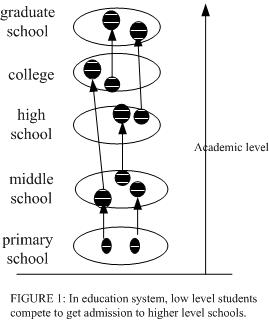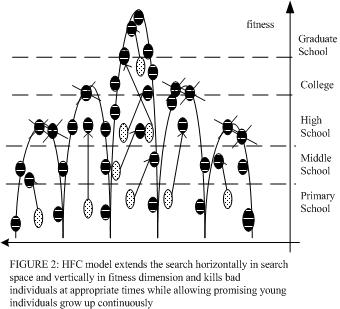|
The HFC model was initially inspired by competition mechanisms observed
in societal and economic systems. Competition is widespread in these
systems, and selection is sometimes very strong, but diversity remains
large. Young individuals with outstanding capabilities in specialized
areas do not have to face immediate competition with the most highly
developed individuals in the population, but can rise rapidly as they
become more able to compete, to play an important role in future
advances. After close examination, we find there is a fundamental
principle underlying many types of competition in both societal and
biological systems: the Fair Competition Principle.
In human society,
competitions are often organized into a hierarchy of levels. None of
them will allow unfair competition – for example, a young child will not
normally compete with college students in a math competition. We use the
educational system to illustrate this principle in more detail.
In the educational
system of China and many other developing countries, primary school
students compete to get admission to middle schools and middle school
students compete for spots in high schools. High school students compete
to go to college and college students compete to go to graduate school
(Figure 1) (in most Western countries, this competition starts at a
later level, but is eventually present, nonetheless). In this
hierarchically structured competition, at each level, only individuals
of roughly equivalent ability will participate in any competition; i.e.,
in such societal systems, only fair competition is allowed. This
hierarchical competition system is an efficient mechanism to protect
young, potentially promising individuals from unfair competition, by
allowing them to survive, learn, and grow up before joining more intense
levels of competition. If some individuals are “lost” in these fair
competitions, they were selected against while competing fairly only
against their peers. If we take the academic level as a fitness level,
it means that only individuals with similar fitness can compete.

An interesting
phenomenon sometimes found in societal competitions is the “child
prodigy.” A ten-year-old child may have some extraordinary academic
ability. These prodigies may skip across several educational levels and
begin to take college classes at a young age. An individual with
sufficient ability (fitness) can join any level of competition. This
also suggests that in subpopulation migration, we should migrate
individuals according to their fitness levels, rather than according to
“time in grade.”

With such a fair
competition mechanism that exports high-fitness individuals to
higher-level competitions, societal systems reduce the prevalence of
unfair competition and the unhealthy dominance or disruption that might
otherwise be caused by “over-achieving” individuals. It maintains
relatively low selection pressure at each level while maintaining the
strong global selection pressure.
Similar
“fair competition” is also enforced in the economic world, where a
variety of regulations and laws (e.g., antitrust laws) are set up
by the government or international organizations to ensure fair
competition and exclude domination. These strategies are necessary to
promote healthy competition and allow new start-ups to have a chance to
mature.
The Fair Competition Principle in Biological Systems
It is
somewhat surprising that in “cruel” biological/ ecological systems, the
fair competition principle also holds in many cases. For example, there
are mechanisms that reduce unmatched or unfair competition between young
individuals and mature ones. Among mammals, young individuals often
compete with their siblings under the supervision of parents, but not
directly with other mature individuals, since their parents protect them
against them. When the young grow up enough, they leave their parents
and join the competition with other mature individuals. Evolution has
found the mechanism of parental care to be useful in protecting the
young and allowing them to grow up and develop their full potentials.
Fair competition seems to be beneficial to the evolution of many
species. |


